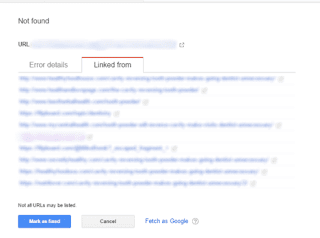Oh, the resolutions keep coming! Based on last year’s 17 link resolutions for 2017, I give you my 18 link resolutions for the new year. Here’s a great start to all your marketing efforts!
1. Educate yourself more about link metrics
I’ve seen so many people referencing link metrics, such as Moz’s Domain Authority or Majestic’s Citation Flow as if they came from Google — and that’s not good. These metrics are attempts at measuring links, and while they can be very useful, you need to look at more than just those numbers.
Take Domain Authority from Moz, for example. It’s a prediction for how well a site will rank. My clients love Domain Authority and tend to insist on a minimum number, but I see plenty of well-ranked sites with low Domain Authority that would be fantastic linking partners. I also see emails where websites are openly selling links, with these emails going to everyone on the planet, and they have good Domain Authority despite my not being able to find them anywhere in the SERPs.
Majestic’s Citation Flow is another one that clients throw at me. It also predicts how influential a site may be.
These link metrics are very useful, and I’m in no way downplaying them, but I do not believe they can be used by themselves, with nothing else taken into consideration. Keep that in mind.
2. Don’t go overboard with disavowals
You shouldn’t disavow every domain that links to you just because it doesn’t have the metrics you want. That’s just crazy!
It’s important to manually evaluate each link before disavowing — for example, just because you get a link on a new page of a new site, that doesn’t mean the link is spammy. You also don’t need to freak out if you have 100 links and 20 of those are from sites with a Domain Authority of 30 or below.
3. Pay attention to your 404s
Most sites experience the occasional 404 error, but what if you notice your site getting hundreds? Excessive 404s can trigger a bad user experience. They’re not good to have when Google crawls your site, either — that’s why Google provides a list of 404 errors in Search Console.
I don’t care how you deal with them, but I do think you need to deal with them. You could have a fantastic site linking to a 404 on your site and be losing out on a lot of good traffic, for example.
1. Educate yourself more about link metrics
I’ve seen so many people referencing link metrics, such as Moz’s Domain Authority or Majestic’s Citation Flow as if they came from Google — and that’s not good. These metrics are attempts at measuring links, and while they can be very useful, you need to look at more than just those numbers.
Take Domain Authority from Moz, for example. It’s a prediction for how well a site will rank. My clients love Domain Authority and tend to insist on a minimum number, but I see plenty of well-ranked sites with low Domain Authority that would be fantastic linking partners. I also see emails where websites are openly selling links, with these emails going to everyone on the planet, and they have good Domain Authority despite my not being able to find them anywhere in the SERPs.
Majestic’s Citation Flow is another one that clients throw at me. It also predicts how influential a site may be.
These link metrics are very useful, and I’m in no way downplaying them, but I do not believe they can be used by themselves, with nothing else taken into consideration. Keep that in mind.
2. Don’t go overboard with disavowals
You shouldn’t disavow every domain that links to you just because it doesn’t have the metrics you want. That’s just crazy!
It’s important to manually evaluate each link before disavowing — for example, just because you get a link on a new page of a new site, that doesn’t mean the link is spammy. You also don’t need to freak out if you have 100 links and 20 of those are from sites with a Domain Authority of 30 or below.
3. Pay attention to your 404s
Most sites experience the occasional 404 error, but what if you notice your site getting hundreds? Excessive 404s can trigger a bad user experience. They’re not good to have when Google crawls your site, either — that’s why Google provides a list of 404 errors in Search Console.
I don’t care how you deal with them, but I do think you need to deal with them. You could have a fantastic site linking to a 404 on your site and be losing out on a lot of good traffic, for example.
4. Stop using the same email outreach template for everything
Our team uses a fairly generic starting template that’s customized based on the client. We have a general template for finance clients, and it does not work for fashion clients. We use one template when we’re trying to get a link on a resource page of a big site and another when we’re trying to get a link on a local blog.
I love templates to start with, but I think you need to personalize them, or you’ll never hear back from anyone.
5. Test your templates
Maybe this template works well in one industry but not in another one. I’ve previously not been so quick to check this, but we once had a new employee who was getting nothing. No responses. Though his template looked great, I figured we had nothing to lose by trying a different one. So we did — and he started getting responses.
We’ve tested including a URL in the initial outreach. We’ve tested different phrasings for the same basic request. It’s fun to test, but it can also really help improve your link success.
6. Proof your general email outreach (again!)
Please, proofread your outreach emails! Have someone else check, too. I routinely look at the outreach emails my team sends, and occasionally, I will see something, whether it’s a typo I missed or poor punctuation. I do think that an email that does not look perfect looks very unprofessional. I wouldn’t respond to that.
7. Stop hounding people
I will absolutely forget to respond to someone and need a follow-up. However, I do not need five follow-ups. Follow up once, maybe twice (maybe) but that really needs to be the end of it. People are very busy, and they’re only getting busier.
8. Have more patience with webmasters
It’s hard to maintain a successful website. You never know what is going on in their lives. We had a really terrible experience where a link builder kept following up with a webmaster because they’d negotiated a link that didn’t go live. After a couple of weeks, the webmaster responded to say he’d been in the hospital after being hit by a car. And yes, he gave us the link.
9. Have more patience with link builders
It’s hard work building links. You may think it’s a piece of cake, but there are days when my team doesn’t get any links. There are times when there are 20 emails back and forth, and a link then doesn’t work out. There are times when we do discovery for three days without finding any good sites that meet our guidelines. Nothing good comes easy, I suppose.
10. Don’t discount webmasters’ opinions
You may approach a webmaster with a specific link request, but it’s important to be open to alternatives. We have had webmasters respond to us and say they’d love to link to our client but not as we’d asked, so we go back to the client with the webmaster’s ideas. Maybe they know of a better page. Maybe they see a better page on our client’s site to link to. It is very rare for the client to say no, as generally, the webmasters know their audience and their site better than we do.
11. Stop being so set on anchor text
Anchor text is obviously important, but the focus on it remains crazy. We’ve worked with a couple of clients who have turned down the opportunity for a good link because the webmaster wouldn’t link with their chosen anchor text (although that’s been rare). No one knows what their users might like more than the webmasters, in my opinion.
12. Stop constantly running numbers and changing everything
So, you’ve built five links with Anchor Text A. Even though it’s still how most people would naturally link to you, you start building links with only Anchor Text B.
Or you now have 10 links pointing to one of your subpages, so obviously you need to back off drawing attention to it and focus on another subpage, whereupon you will get 10 links and move on to another page.
While it’s good to be conscious of link diversity, constantly changing focus is not good — especially when it consumes you.
13. Don’t think that just because it’s working for your competitors, it’s going to work for you
A competitor might have a successful blog that gets a lot of attention, but maybe it’s a really small space, and there’s just not room for you to do the same thing. They may have 100 linking domains, while you have 85. Getting 15 more is not the only answer for you.
14. Read Google’s guidelines for yourself
Don’t believe every crazy thing you’re told. Recently, a webmaster told us that Google would penalize any site using branded anchor text. Not true. Google updates the guidelines regularly. Read them regularly.
15. Stop looking at the rankings 10 times a day and freaking out
Sometimes there is a lot of volatility, and you’ll see your site on page 2, then page 10, then page 3. If it’s bouncing around that much, you’re better off just not looking for a bit.
16. Pay close attention to Google Analytics and Search Console
We still get clients who haven’t set these up. If Google is giving you information for free, you need to take advantage of it. You can integrate the two and get some powerful data that can help you figure out where your problems are and how to fix them.
17. Don’t forget to pursue other avenues of traffic
We have clients who do really well in Bing. My site’s main source of traffic is referrals from this very column. Some sites get their main business from Facebook. Even if you do rank really well in Google, it’s wise to try to do well elsewhere, whether that means referrals from other sites, other search engines or social.
18. Remember your SEO fundamentals
Links can be the answer, but they aren’t always. Even with a great link-building program in place, it can be difficult to rank well if your on-site SEO isn’t properly done.
More Info: SEO Service in USA





Comments
Post a Comment